5 Must-Know Project Scope Control Strategies
Discover 5 essential project scope control strategies that help project managers handle change, maintain focus, and keep projects on time and on budget.
In project management, few challenges are as constant or as critical as managing the project scope. It defines what a project will deliver, what it will not, and the boundaries that shape every task and decision. When project scope is unclear or poorly controlled, projects drift away from their goals, costs climb, and deadlines slip.
The good news is that scope control is not about eliminating change. It is about guiding change through structure, communication, and discipline. With the right strategies, you can protect the integrity of your scope while keeping your team adaptable.
This guide explores five must-know strategies to help you manage project scope effectively, reduce risk, and build confidence among your stakeholders.
Understanding Project Scope and Why It’s So Hard to Control
To control project scope, you first need to understand what scope is in project management. There are two main types of scope: product scope and project scope. The project scope definition describes the overall boundaries of a project: its objectives, deliverables, tasks, and constraints. It answers the questions what are we building, why are we building it, and what are we not doing?
Closely related is the scope of work, a detailed document that breaks down exactly what needs to be done to achieve the project’s objectives. Understanding the scope of work meaning helps clarify roles and responsibilities across the team.
Despite careful planning, scope control often becomes one of the hardest parts of project management. Changes are inevitable. Clients evolve their expectations, market conditions shift, or technical discoveries emerge midway through development. Without a plan to handle these shifts, scope creep quickly takes hold.
Scope creep occurs when new features, requirements, or deliverables are added without adjusting time or budget. It is one of the most common causes of project delays and overruns. The challenge, therefore, is not to resist change but to manage it in a way that keeps the project aligned with its goals.
The Role of Project Scope in the Triple Constraint
The project scope sits at the center of what project managers call the triple constraints of project management: scope, time, and cost. These three factors are tightly linked. If one changes, the others are affected.
For example, when the scope expands to include additional features, it often requires more time and a higher budget. Similarly, if funding is reduced, the scope may need to shrink to maintain quality and meet deadlines.
Understanding this relationship is essential for effective project management. It allows you to anticipate the impact of scope changes before they disrupt progress. Strong scope control keeps all three elements balanced, helping you deliver predictable outcomes even when conditions shift.
5 Project Scope Control Strategies Every Manager Should Know
The following five strategies provide a practical framework for managing project scope with confidence and control.
1. Adopt a Change-Ready Mindset
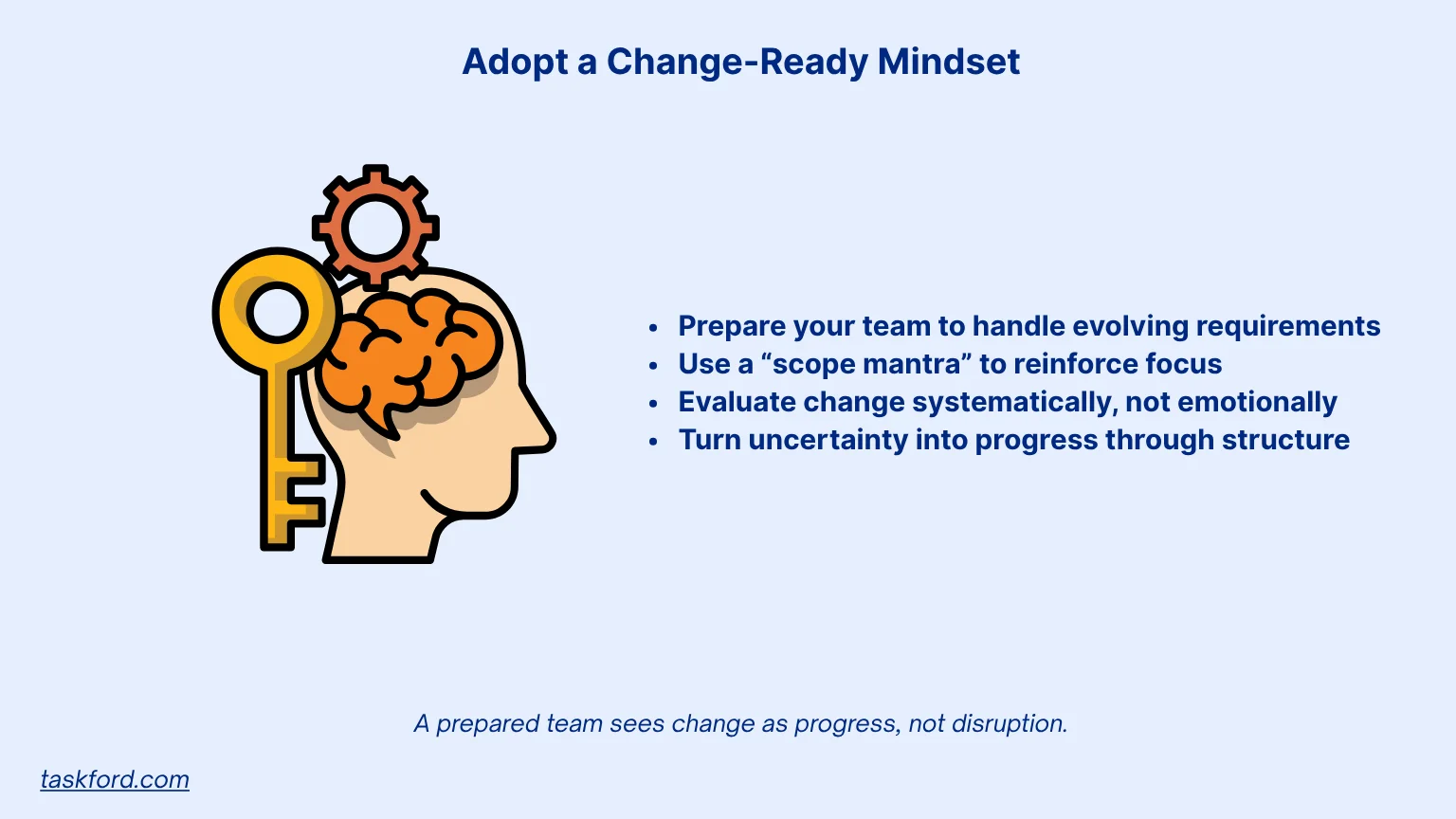
Change is inevitable in every project. Instead of resisting it, prepare for it.
Start by reminding your team that no project runs exactly as planned. Requirements evolve, stakeholders adjust priorities, and unexpected constraints appear. Viewing these changes as opportunities rather than setbacks helps maintain momentum and morale.
Create a short “scope mantra” to keep everyone grounded. For example, "Change will happen, and we will manage it". This statement reinforces calm and control when new requests arise.
A change-ready mindset does not mean accepting every request. It means expecting change and using structure to evaluate it. When your team sees change as part of the process, you transform uncertainty into progress.
2. Use Technology to Manage Project Scope Changes
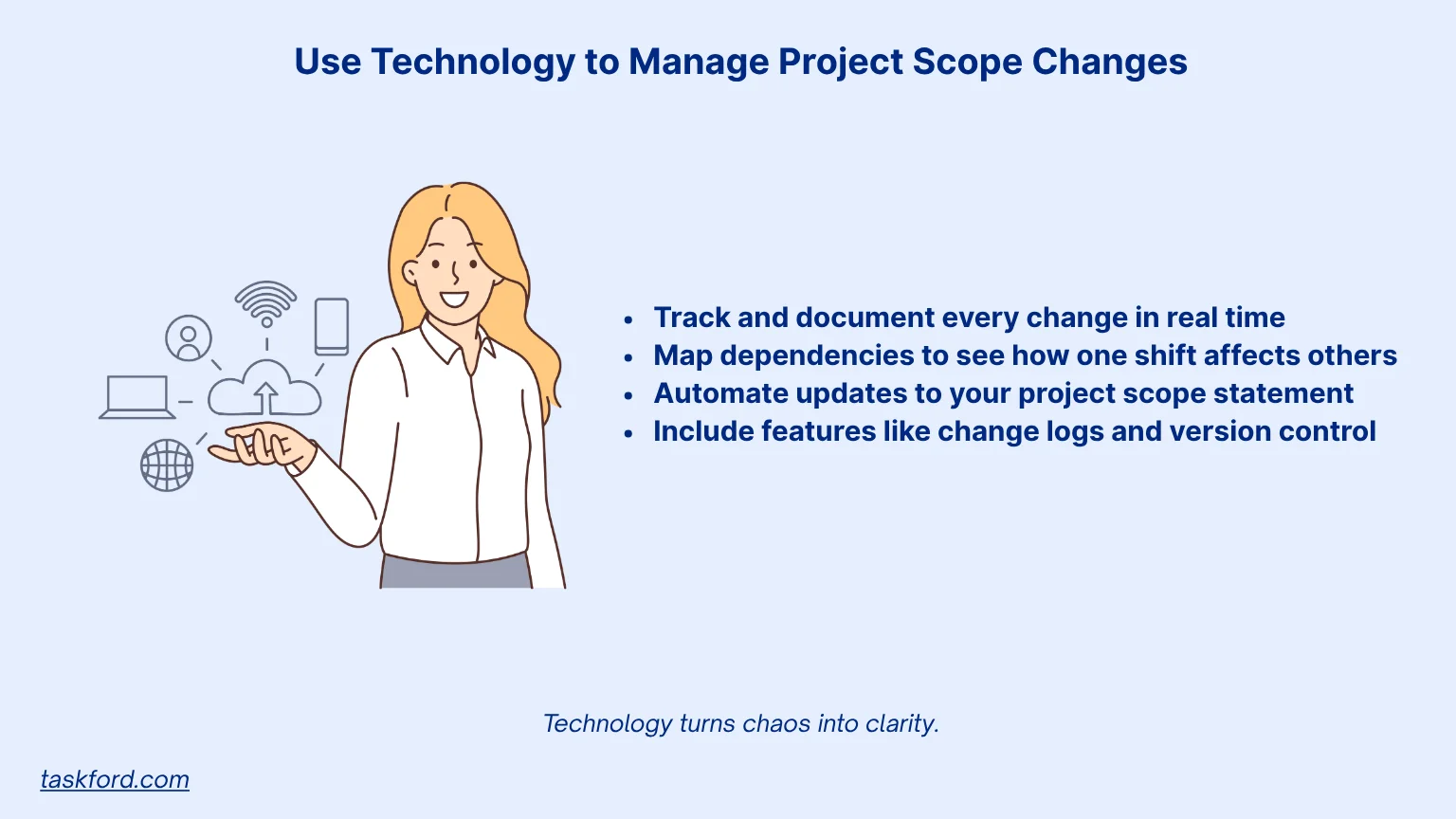
Modern project management tools are powerful allies in controlling project scope. They allow teams to track, document, and visualize the impact of change in real time.
A good tool helps you map dependencies between tasks, update schedules automatically, and record approvals or rejections of scope modifications. Features like change logs, automated alerts, and version control create a clear audit trail of decisions.
For example, when a client requests an additional deliverable, the project manager can instantly assess how it affects the timeline and budget. After checking the changes, they can create an updated project scope statement that reflects the new agreement.
Technology supports transparency. When project stakeholders can see how changes are tracked and approved, trust increases and miscommunication decreases.
Whether you use an enterprise platform or a smaller collaboration tool, ensure it includes:
- Change request tracking
- Impact assessment fields
- Notification features for stakeholders
- Version history for your project
By integrating technology into your process, you make scope control systematic and verifiable rather than reactive.
3. Form a Change Control Board (CCB)
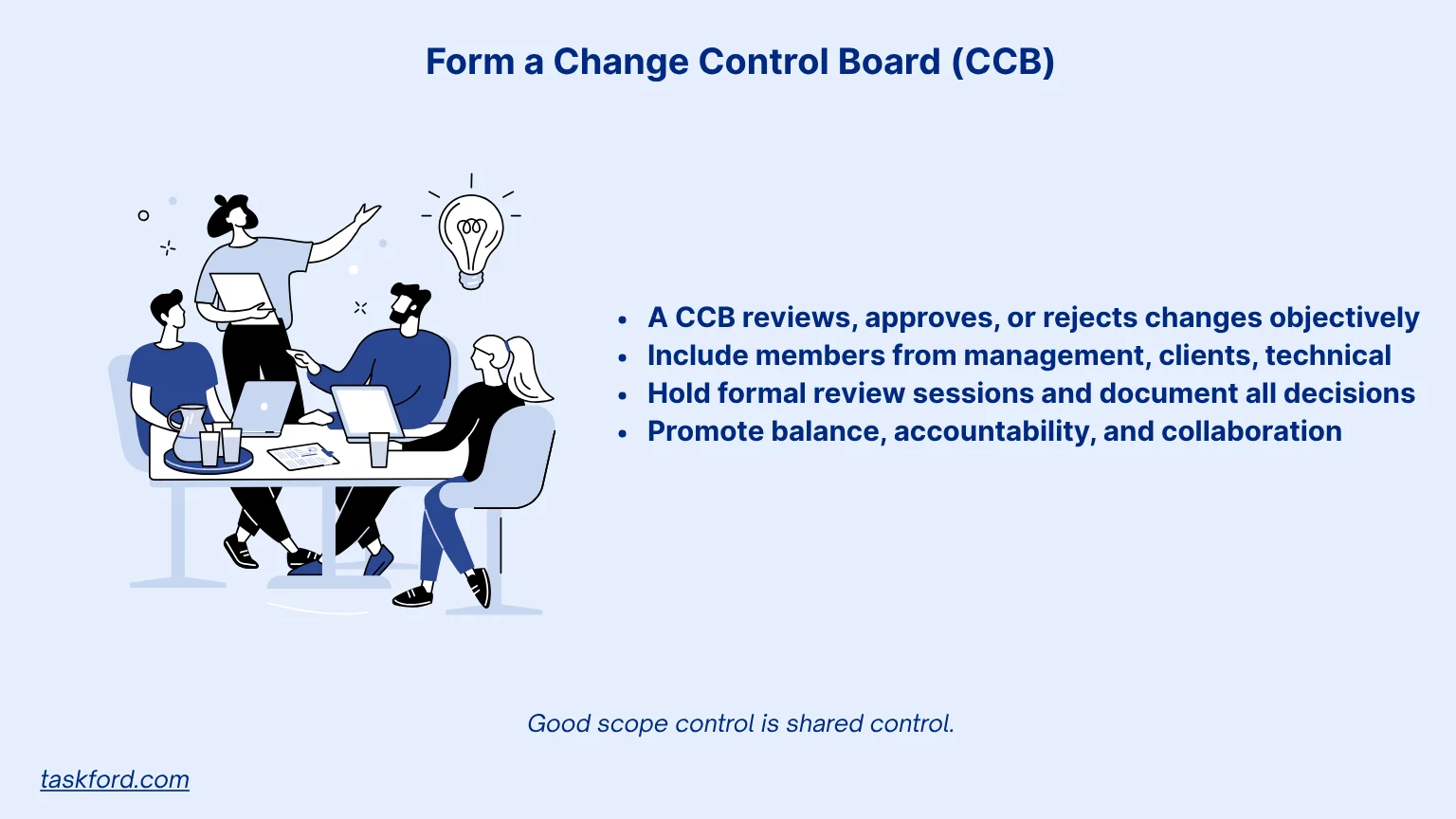
One of the most effective ways to strengthen project scope governance is to form a Change Control Board (CCB). This board is a group of key stakeholders responsible for reviewing, approving, or rejecting scope changes.
A CCB distributes authority and ensures that the project manager is not the sole decision-maker. It adds balance by including representatives from management, technical teams, clients, and sometimes finance. Each member brings a different perspective on how proposed changes might affect the project.
A well-structured CCB process usually includes:
- A formal meeting schedule to review pending changes
- Evaluation of each change’s impact on cost, time, and risk
- Documentation of decisions for accountability
- Clear communication back to the project team
Having a CCB prevents impulsive or informal changes from slipping through. It ensures that all scope adjustments are deliberate, justified, and aligned with project goals.
More importantly, it fosters collaboration. When stakeholders participate in decision-making, they become invested in keeping the scope realistic and achievable.
4. Establish a Formal Project Scope Change Process
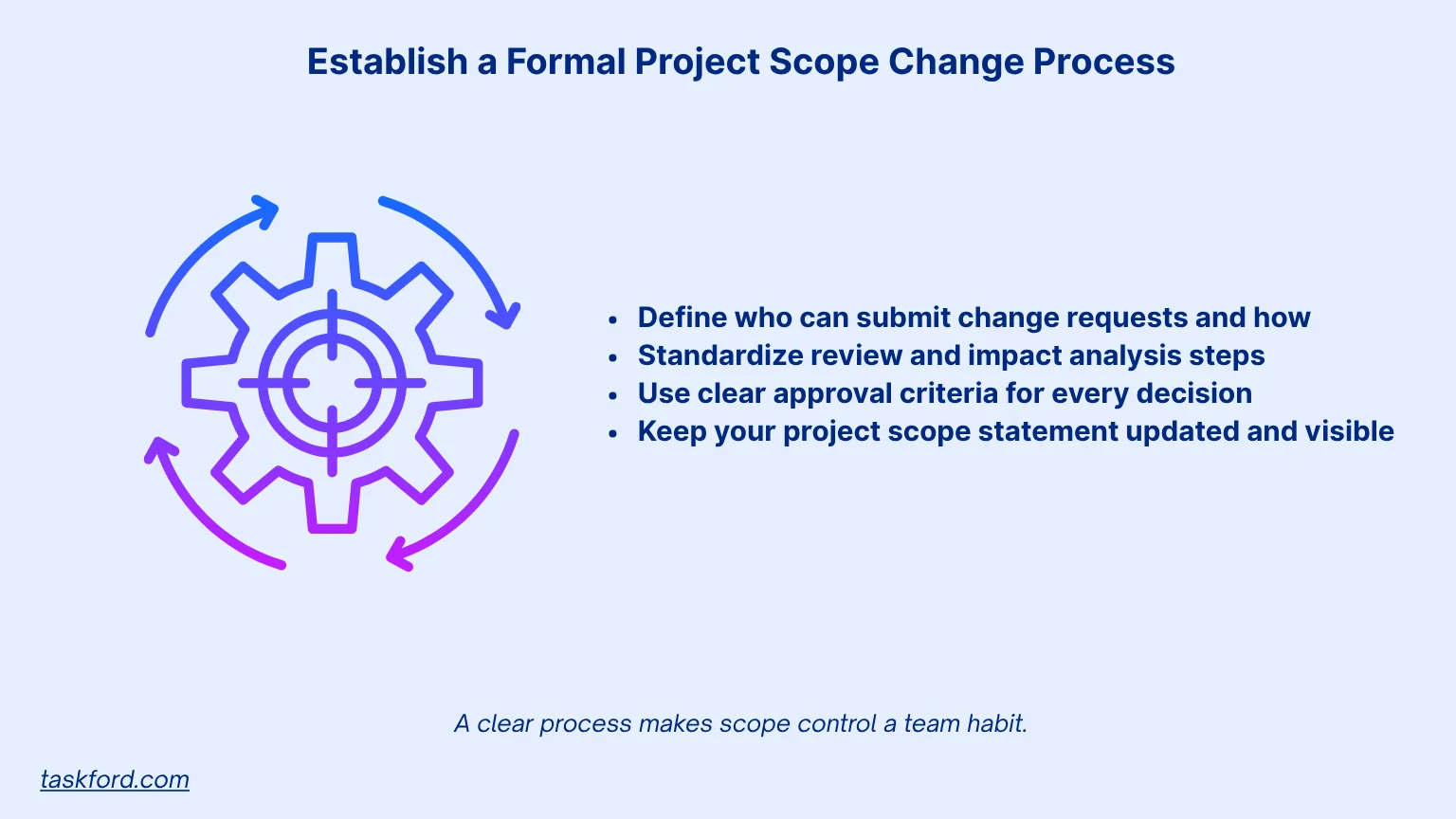
A clear, documented process is the backbone of project scope control. It defines how changes are proposed, reviewed, and approved so no step is missed.
Every project should answer these key questions:
- Who can submit a change request?
- How should that request be documented?
- Who reviews it, and what criteria are used to evaluate it?
- When and how is the decision communicated?
A strong process brings transparency and consistency. It also allows teams to assess how each change will affect time, cost, and risk before approval.
Here is a simple framework to guide your process:
- Submission: Any stakeholder who identifies a needed change completes a standard request form.
- Review: The project manager checks it for clarity and relevance.
- Impact Analysis: The team evaluates effects on schedule, budget, and resources.
- Decision: The Change Control Board or sponsor approves or rejects it.
- Implementation: Approved changes are reflected in the updated project scope statement and communicated to the team.
Keeping your project scope statement current ensures everyone works from the same understanding of project deliverables and boundaries. When your process is clear, scope control becomes a shared discipline rather than a top-down rule.
5. Communicate the Project Scope Control Process Clearly
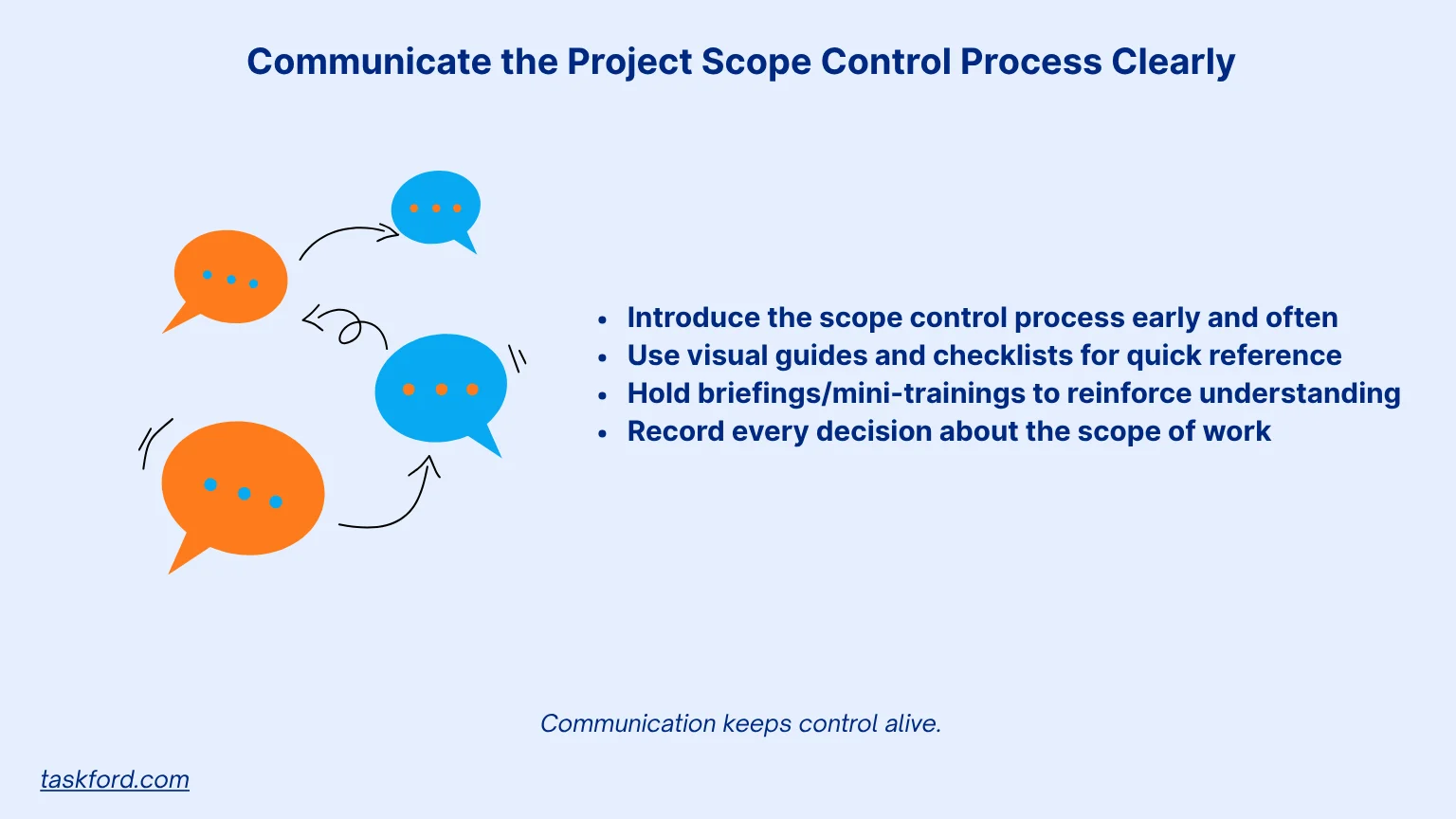
Even the best scope control process fails without proper communication. Every team member should understand how changes are handled, who approves them, and what documentation is required.
Start communication early. Introduce the process during project kickoff and share visual guides that outline each step. Revisit these guides during major milestones to keep awareness high.
To maintain engagement:
- Provide short training sessions or internal briefings.
- Create quick-reference checklists for submitting change requests.
- Encourage open discussion about potential scope risks before they escalate.
Avoid informal side agreements that bypass official procedures. Every decision about the scope of work should be recorded in writing.
When communication is clear and consistent, everyone knows how to act when change occurs. That clarity prevents confusion, builds accountability, and reinforces discipline across the team.
Turning Project Scope Control Into Effective Governance
When applied together, these five strategies can transform how you manage project scope. They move you from reacting to change toward leading it through a clear, organized framework.
Effective governance replaces control with structure. Instead of relying on one person to make every decision, governance distributes authority through systems and processes. This shift allows change to occur responsibly without losing sight of project objectives.
Here’s how strong scope control evolves into effective governance:
- It replaces control with structured decision-making. Governance ensures that project changes are handled through defined approval processes, not ad hoc choices. This makes your project less vulnerable to bias or unclear authority.
- It builds stakeholder trust through transparency. When every scope change is documented, reviewed, and approved visibly, stakeholders understand that nothing slips through unnoticed. This openness turns potential conflicts into collaboration.
- It reinforces accountability with an updated scope statement. The scope statement becomes a living document that reflects the project’s current direction. Keeping it current clarifies what’s included, what’s changed, and what remains outside the project’s boundaries.
- It allows flexibility without losing control. Good governance doesn’t mean rejecting all changes, it means saying “yes” only to those that align with project goals, resources, and timelines.
- It creates a disciplined environment for sustainable delivery. By focusing on governance instead of gatekeeping, project managers build a culture where the team can adapt quickly while maintaining strategic focus.
In the end, project scope control isn’t just about preventing scope creep. It’s about establishing a governance model that balances flexibility with discipline, keeping your project on course even as conditions evolve without any scope creep.
Final Thoughts
Project scope control is one of the most important skills in project management. It demands structure, communication, and a proactive attitude toward change. By adopting a change-ready mindset, leveraging technology, forming a change control board, establishing a formal process, and communicating it clearly, you build a framework that protects your project from unnecessary risk.
Whether you are managing a small internal initiative or a large enterprise project, these strategies help you stay in command of your project scope without stifling progress.
Control the scope, and you control the project.
Learn more
- What Is Project Management? A Beginner’s Comprehensive Guide 2026
- What Does A Project Manager Do? A Guide to Advancing Your Career
- AI in Project Management: A Look at 2026 and Beyond
Making work simpler,
smarter, and more connected
Join our waitlist and be notified first.

Subscribe for Expert Tips
Unlock expert insights and stay ahead with TaskFord. Sign up now to receive valuable tips, strategies, and updates directly in your inbox.






